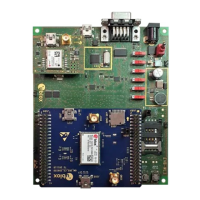SARA-R5 series - System integration manual
UBX-19041356 - R04 System description Page 17 of 118
C1-Public
1.5.1.1 VCC supply requirements
Table 5 summarizes the requirements for the VCC modules supply. See section 2.2.1 for suggestions
to correctly design a VCC supply circuit compliant with the requirements listed in Table 5.
⚠ The supply circuit affects the RF compliance of the device integrating SARA-R5 series modules
with applicable required certification schemes as well as antenna circuit design. Compliance is
guaranteed if the requirements summarized in the Table 5 are fulfilled.
Within VCC normal operating range:
3.3 V / 4.4 V
RF performance is guaranteed when VCC voltage is inside
the normal operating range limits.
RF performance may be affected when VCC voltage is
outside the normal operating range limits, though the
module is still fully functional until the VCC voltage is
inside the extended operating range limits.
VCC voltage during
normal operation
Within VCC extended operating range:
3.0 V / 4.5 V
VCC voltage must be above the extended operating range
minimum limit to switch-on the module.
The module may switch-off when the VCC voltage drops
below the extended operating range minimum limit.
Operation above VCC extended operating range is not
recommended and may affect device reliability.
Support with adequate margin the
highest averaged VCC current
consumption value during Tx
conditions specified in the SARA-R5
series data sheet [1]
The maximum average current consumption can be
greater than the specified value according to the actual
antenna mismatching, temperature and supply voltage.
Section 1.5.1.2 describes current consumption profiles in
connected mode.
Noise in the supply pins must be
minimized
High supply voltage ripple values during RF transmissions
in connected mode directly affect the RF compliance with
the applicable certification schemes.
Table 5: Summary of VCC modules supply requirements
1.5.1.2 VCC current consumption in LTE connected mode
During an LTE connection, the SARA-R5 series modules transmit and receive in half duplex mode. The
current consumption depends on output RF power, which is always regulated by the network (the
current base station) sending power control commands to the module. These power control
commands are logically divided into a slot of 0.5 ms (time length of one Resource Block), thus the rate
of power change can reach a maximum rate of 2 kHz.
Figure 7 shows an example of SARA-R5 series modules’ current consumption profile versus time in
connected mode: transmission is enabled for one sub-frame (1 ms) according to LTE Category M1
half-duplex connected mode. For detailed consumption values, see the SARA-R5 series data sheet [1].
Current [mA]
Time
[ms]
0
300
200
1 00
400
Current consumption value
depends on TX power and
actual antenna load
1 Slot
1 Resource Block
(0.5 ms)
1 LTE Radio Frame
(1 0 ms)
1 Slot
1 Resource Block
(0.5 ms)
1 LTE Radio Frame
(1 0 ms)
Figure 7: VCC current consumption profile versus time during LTE Cat M1 half-duplex connection

